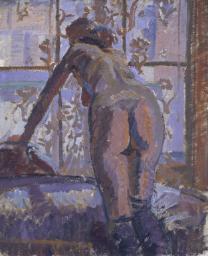Author unknown, ‘Picture Shows. The Camden Town Group’
The Times, 11 December 1911, p.12.
PICTURE SHOWS.
THE CAMDEN TOWN GROUP.
The Camden Town Group is not a school, but only a convenient name for a number of artists who exhibit together. Their second exhibition, now to be seen at the Carfax Gallery, is well worth a visit.
Mr. Walter Sickert, in all of his four pictures, successfully avoids the picturesque, which is the most insidious vice of painting, as the literary is of writing. It is just as easy to be picturesque with Cockneys as with Italian peasants. Directly the subject of a picture looks as if it had been exploited to make the picture it becomes picturesque, no matter what that subject may be. Mr. Sickert’s “Mother and Daughter” (12) have not been exploited. As you look at them you are interested only in them, not in the artist or even in the picture. There is no attempt at illusion, but he sets two living people before you and gives you the impression that they have been made what they are by their experiences. Mr. H. Gilman, who shows the influence of Mr. Sickert, does not produce quite the same impression with his two very able nudes (20 and 22). They look as if they were sitting to be painted, not as if the artist had surprised them at some characteristic moment. You scarcely notice Mr. Sickert’s colour, it belongs so entirely to his subjects. But Mr. Gilman’s colour seems rather to be imposed upon his subjects, though it surprises with its freshness and ingenuity. His pictures are very well made, but they are made, whereas Mr. Sickert’s seem to have grown. Mr. Lamb’s portrait (5) is also very well made; but he seems to have chosen his sitter to illustrate a method of painting. He is still making artistic experiments, and we cannot tell yet what he has to say himself about the visible world. Mr. J. D. Innes is in the same state, making ingenious little pictures after the latest fashion rather than trying to discover what really interests him in reality.
Mr. Wyndham Lewis exhibits three geometrical experiments which many people will take for bad practical jokes. They are not that, but this geometrical art needs great beauty of material, as in mosaic or stained glass, or else a very strong emotion to carry it off. Without either or both of these it is merely diagrammatic, as in Mr. Lewis’s pictures. Mr. C. Ginner, in his “Café” (29), has grappled bravely with very garish materials, and has made a picture which is neither garish in itself nor agreeably unreal. Mr. L. Pissarro in his landscapes avoids all picturesqueness and all cleverness; yet he expresses the character of a place so clearly that he is never dull. It is easy to overlook his little pictures, but they improve on acquaintance and would be very pleasant to live with.
How to cite
Author unknown, ‘Picture Shows. The Camden Town Group’, in The Times, 11 December 1911, p.12, in Helena Bonett, Ysanne Holt, Jennifer Mundy (eds.), The Camden Town Group in Context, Tate Research Publication, May 2012, https://www

